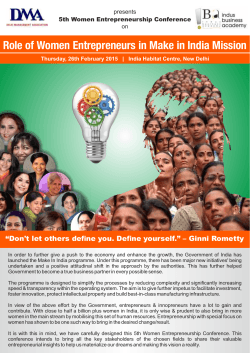
5 Ways Government Policies help Business Innovation
LEADERSHIP WAYS GOVERNMENT POLICIES HELP BUSINESS INNOVATION I BY DAVID LEVINE, CO-FOUNDER AND CEO, AND RICHARD EIDLIN, CO-FOUNDER AND VICE PRESIDENT OF POLICY, AMERICAN SUSTAINABLE BUSINESS COUNCIL t’s gospel among American politicians and business leaders: innovation is key to the success of individual companies and entire industries. And yet, many of these same people contend that to optimize innovation, government needs to stay out of the way. We disagree and believe there are many opportunities for business and government to work together. Government has played a pivotal role in spurring innovation throughout American history. Think of the national train system in the 1880s, in which federal authorities mediated among a small group of monopolies to establish a standard gauge for all railroads so rolling stock could be shipped anywhere in the US, from one line to another. Or consider the basic research grants that enabled the invention and development of the semiconductor, with the Defense Department serving as the initial risk-taker and customer. Today, the stakes are high; the health of our planet and our economy depend on innovation occurring on a massive scale. America’s international competitiveness is also at stake. As a percentage of total federal spending, R&D [research and development] is at its lowest levels since 1956. In contrast, China doubled its R&D expenditures between 2008 and 2012. Government support of innovation should be a complement though, not a replacement for private ingenuity and risk-taking. The American experience of public sector involvement, in contrast to many European nations, rarely ends up stifling innovation, capturing the best talent, or otherwise depressing market forces. Successful outcomes require smart policies that recognize and then work to correct market failures (e.g., imperfect information and externalities). The guiding hand of government is a fundamental condition for success. And for effective government support of innovation to occur, responsible business leaders need to advocate for it. HERE ARE FIVE AREAS WHERE CONCERNED BUSINESS LEADERS SHOULD CONSIDER ENGAGING: 1. RULES AND REGULATIONS When the Clean Water Act and Clean Air Act passed in Other companies, however, embraced the challenge and reoriented their entire production processes to “design out” the pollution. Their new products required less raw material to produce (reducing costs), and had a higher degree of quality (thus increasing the price they commanded in the market). consumers eager for environmentally superior products. Regulations can indeed sometimes be challenging to adapt to or burdensome to comply with in the short term. They may require a reallocation of resources and adjustment of business models. Regulations must not be designed to reduce competition or prop up incumbent industries. Instead, they should be crafted to stimulate innovation, break up monopolies, and protect the common good. CONSCIOUS COMPANY MAGAZINE | SPRING 2015 2. INCENTIVES AND DISINCENTIVES outcomes. Seeking to address climate change by putting a price on carbon is one important example. We think it’s time that Congress acknowledges the macro “free rider” problem of climate change by setting a price on carbon, ideally “upstream” on the nation’s largest CO2 emitters. The to shift consumption patterns and investment decisions. The price needs to be set high enough to encourage a shift in the extraction and production processes of fossil fuels as well as towards using cleaner fuels. And, we believe that a price on overall level of federal subsidies for solar, wind, nuclear, etc. What the revenues from a price on carbon are used for is open LEADERSHIP “Today, the stakes are high; the health of our planet and our economy depend on innovation occurring on a massive scale.” for discussion, but some ideas we favor include infrastructure investment, supporting the economic transition of coal intensive communities, and lowering worker payroll taxes. Any discussion of federal or state energy incentives needs to appreciate the long-standing support (e.g., tax credits, depreciation allowances, insurance coverage) policymakers have provided the coal, nuclear, and oil and gas industries. it should no longer be supported by taxpayers. In time, renewables will achieve parity and government subsidies will not be needed. Until that happens, government has a role to play in helping foster nascent industries. 3. INDIRECT INVESTMENT Remember when you drove your family down to the a pivotal role in enabling that. The Interstate Highway System is a perfect example of what’s called “pump priming” - stimulating the economy, mostly through government spending. In this case, the federal government provided funds to build the Interstate system (around $425 billion in 2006 dollars, by one estimate). It resulted in massive increased economic activity - not just construction and maintenance, but increased commerce and tourism between states. And without government investment, it wouldn’t have happened. Or take basic research. The private sector often shies away from research that has a long lead time before it can be monetized. So, we have government funding of research at the university level. For example, the National Institute of Environmental Health Sciences provides grants to measure and investigate how the environment impacts human health. The science that emerges can be used by the private sector to develop new products and services. voluntary program run by the US EPA, which helps businesses and institutional buyers identify and choose cleaning and other products that perform well and are safer for human health and the environment. 4. DIRECT INVESTMENT Anyone who followed the Solyndra debacle knows that any direct investment, in the public or private sector, is risky. Energy and ultimately defaulted. Here’s what you may not know: the program responsible for the Solyndra loan also made a great many others - and is the clean energy market and enabled similar companies to get loans from the private sector more easily. In many cases, when the private sector is unable or unwilling to take investment risks to foster new directions or even new industries, the government can play a vital, direct role. 5. GOVERNMENT AS FIRST MOVER from the government being an early adopter. Our electronic systems have been dependent on semiconductors, especially tube was still the popular technology. transistors. The federal government essentially provided a market for transistors, making it possible for the private sector to develop its products at a time when a private sector market didn’t exist. Without government involvement, it wouldn’t have been possible, or at least would not have happened nearly as quickly, to see these products come to market. Our mixed economy works best when the public and private sectors collaborate. Each has a unique role. The private sector excels at being nimble and responsive. failures. Together, the opportunity to enhance innovation and The downside risk of government involvement is that by special interests, or too bureaucratic. Business leaders must provide guidance for strengthening these processes. In today’s political environment, we know that too much of government policy-making has become dominated by Forward-thinking business leaders who believe in both a vibrant democracy and economy should engage in the public policy process. Make sure your values and visions are known to policy-makers, lest those who hold a more parochial view dictate the future. Founded in 2009, ASBC and its organizational members now represent more than 200,000 businesses and more than 325,000 business leaders across the United States. These diverse business organizations include trade associations, local and state chambers of commerce, microenterprises, social enterprises, cooperatives, green and sustainable business groups, local main street businesses, women business leaders, economic development organizations, and investor and business incubators. ASBC has been joined by a wide range of companies including Patagonia, Eileen Fisher, Ben & Jerry’s, Seventh Generation, Clif Bar, Etsy, New Belgium Brewing, Green Depot, New Resource Bank, and Trillium Asset Management. ASBC informs and engages business leaders while educating policy makers and the media about the need and opportunities for a sustainable economy. www.asbcouncil.org SPRING 2015 | CONSCIOUS COMPANY MAGAZINE
© Copyright 2025



















